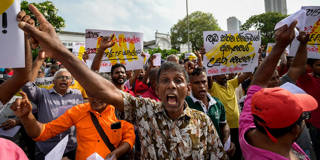The recent bailout agreement between the International Monetary Fund and Sri Lanka fails to address the economy’s structural problems. Instead, it focuses on highly regressive measures that disproportionately affect the working poor and are likely to exacerbate the country’s ongoing debt distress.
COLOMBO – More than a year after the mass protest movement known as the Aragalaya ousted Sri Lanka’s President Gotabaya Rajapaksa and his brother, Prime Minister Mahinda Rajapaksa, Sri Lankans have once again taken to the streets.
The impetus for the resurgence of public discontent is the recent bailout agreement between the International Monetary Fund and President Ranil Wickremesinghe’s government. The deal, which aims to address the country’s ongoing balance-of-payments crisis, offers Sri Lanka less than $3 billion over four years – a tiny fraction of what the country needs to meet its debt-servicing requirements and just one-sixth of its foreign-exchange earnings, which amounted to roughly $18 billion in 2022.
In exchange for this emergency loan, the IMF imposed a series of conditions that have significantly exacerbated Sri Lanka’s wage and cost-of-living crises. The mandated shift to market exchange rates, in particular, immediately led to a sharp currency devaluation, causing imported fuel and food prices to skyrocket and contributing to a 165% increase in electricity tariffs between June 2022 and February 2023.

COLOMBO – More than a year after the mass protest movement known as the Aragalaya ousted Sri Lanka’s President Gotabaya Rajapaksa and his brother, Prime Minister Mahinda Rajapaksa, Sri Lankans have once again taken to the streets.
The impetus for the resurgence of public discontent is the recent bailout agreement between the International Monetary Fund and President Ranil Wickremesinghe’s government. The deal, which aims to address the country’s ongoing balance-of-payments crisis, offers Sri Lanka less than $3 billion over four years – a tiny fraction of what the country needs to meet its debt-servicing requirements and just one-sixth of its foreign-exchange earnings, which amounted to roughly $18 billion in 2022.
In exchange for this emergency loan, the IMF imposed a series of conditions that have significantly exacerbated Sri Lanka’s wage and cost-of-living crises. The mandated shift to market exchange rates, in particular, immediately led to a sharp currency devaluation, causing imported fuel and food prices to skyrocket and contributing to a 165% increase in electricity tariffs between June 2022 and February 2023.